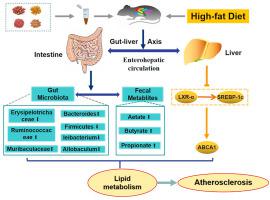Journal of Ethnopharmacology ( IF 4.8 ) Pub Date : 2020-10-01 , DOI: 10.1016/j.jep.2020.113436 Yaxin Zhang , Yuyan Gu , Yihao Chen , Zhiyong Huang , Mei Li , Weihao Jiang , Jiahui Chen , Wenting Rao , Shangfei Luo , Yuyao Chen , Junqi Chen , Lijun Li , Yuhua Jia , Menghua Liu , Fenghua Zhou

|
民族药理学意义
定心方(DXR)是一种传统中药配方,据报道可有效,安全地治疗心律失常,冠心病等心血管疾病。鼎欣食谱IV(DXR IV)是根据传统用法从DXR进一步改进的。但是,DXR IV在动脉粥样硬化中的机制尚不清楚。
研究目的
这项研究旨在说明DXR IV是否通过调节动脉粥样硬化小鼠的脂质代谢和肠道菌群来改善动脉粥样硬化。
材料和方法
将40只雄性ApoE -/-小鼠用HFD喂养12周,然后用DXR IV(1.8、0.9或0.45 g / kg / d)治疗另外12周。DXR IV的死法包含四种中药:黄连的干根茎。(15.09%)是丹参(Salvia miltiorrhiza Bunge)的根(28.30%),是枣(Zipziphus jujuba Mill)的种子。(37.74%)和灵芝子实体(Leyss.ex Fr.)岩溶。(18.87%)。喂养正常饮食的8只雄性c57BL / 6小鼠作为对照组。通过油红色O染色和masson三色染色对动脉粥样硬化斑块进行定量。收集小鼠粪便。通过16S rRNA基因测序检测肠道微生物区系,并通过粪便代谢产物分析。1 H NMR光谱。研究了DXR IV对血脂(TG,TC,LDL-C,HDL-C)的影响。分别通过RT-qPCR和western blotting确定脂质代谢相关基因。
结果
DXR IV通过抑制主动脉中过多的胆固醇沉积并调节TG,TC,LDL-C和HDL-C的水平发挥抗动脉粥样硬化作用。肠道菌群的组成发生了变化。有趣的是,相对丰度Muribaculaceae和Ruminococcaceae DXR IV给药后增加,而丰丹毒丝降低,这对脂质代谢是有益的。确定了九种潜在的代谢生物标志物,包括乙酸盐,丁酸盐,丙酸盐,丙氨酸,琥珀酸盐,戊酸盐,木糖,胆碱,谷氨酸,它们与脂肪酸代谢有关。此外,通过RT-qPCR和蛋白质印迹检测脂肪酸的途径。与模型组相比,DXR IV组LXR-α和SREBP1水平明显降低,而LXR-β,SREBP2水平无统计学意义。这表明DXR IV通过LXR-α/ SREBP1调节脂质代谢,但不通过LXRβ和SREBP2调节脂质代谢。
结论
DXR IV具有潜在的抗动脉粥样硬化作用,与脂质代谢和肠道菌群密切相关。这项研究可能提供有关DXR IV在动脉粥样硬化中的机制的新颖见解,并为有前途的临床应用奠定基础。

"点击查看英文标题和摘要"


















































 京公网安备 11010802027423号
京公网安备 11010802027423号